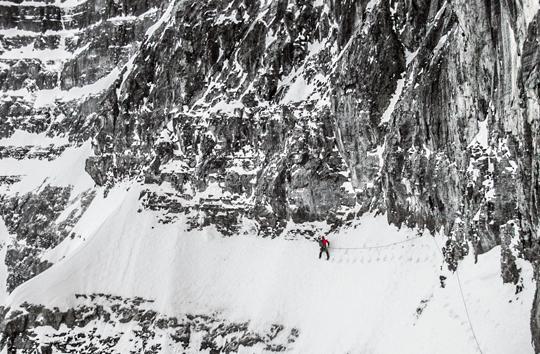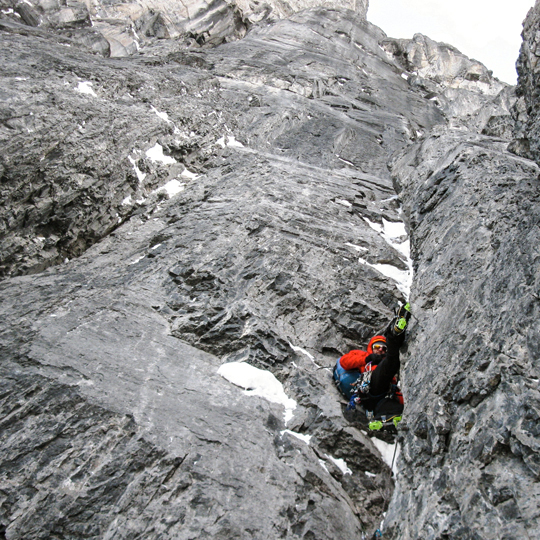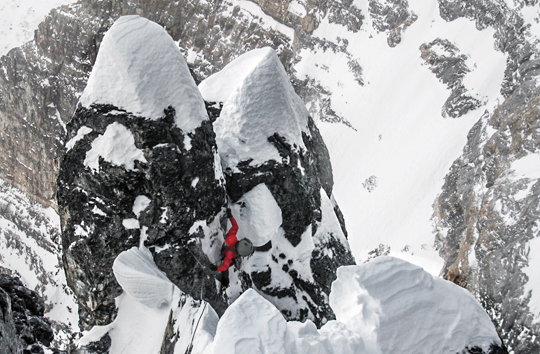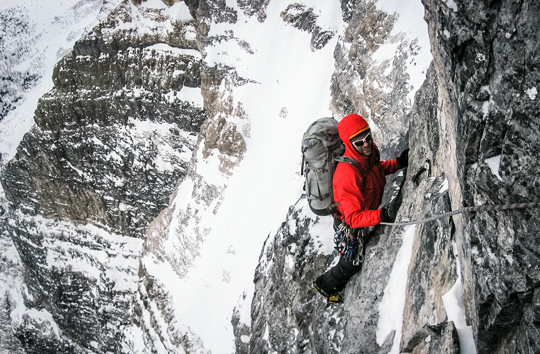
[Photo] Alik Berg
They call the Canadian Rockies’ Mt. Temple the Eiger of North America. Both peaks offer sheer north faces with steep imposing headwalls that soar 1500 meters above the valleys below, both feature compact limestone, both are regularly subject to tempestuous weather that can appear out of seemingly calm skies. Perhaps most importantly, both are steeped in mystery, lore and ominous histories. The tales of the many climbers who perished on the Eiger Nordwand are well documented. In his book Eiger Dreams, Jon Krakauer writes, “the problem with climbing up the North Face of the Eiger, is that in addition to getting up 6,000 vertical feet of crumbling limestone and black ice, one must climb over some formidable mythology.”
In North America, and particularly in Banff, Mt. Temple is infamous. As with the Eiger, the first ascent of the north face of Mt. Temple remained a coveted alpine goal long after the first ascent of the peak in 1894, via the west ridge. Like the Eiger, Temple has seen its own share of fatalities. In 1955 seven American teenagers were killed in an avalanche while retreating after an attempt of the southwest ridge. And in 1986–twenty years after the wall’s eventual first ascent–four climbers were killed in two separate accidents on the north face because of ice fall, prompting the then-Banff warden, Tim Auger, to remark that “the north face is not a good bet for climbing…one person in 20 or 30 is going to get killed climbing that route.”

The first ascent of Mt. Temple’s north face didn’t take place until July 1966–28 years after the Eiger Nordwand succumbed. The first winter ascent of Mt. Temple’s north face came eleven years later in 1977, when Carlos Buhler and Phil Hein climbed the Elzinga-Miller into the Lowe route. Over nearly three decades following the wall’s first winter ascent, further successful climbs of the face remained few and far between. The Greenwood-Locke route, in particular, remained a coveted goal and it was not climbed in winter until 2004–by Raphael Slawinski and Ben Firth. In an Alpinist Newswire following their ascent, Firth wrote, “Roughly ten attempts had been made on the route over the past twenty years… dry tooling experience on multi-pitch rock routes on the long-time training crag of Yamnuska…would prove the key to our success.” Slawinski noted that the Greenwood-Locke route was “significantly safer, but much more difficult [than the Elzinga-Miller].” In the same season, Slawinski went on to climb the “obscure Robinson-Orvig, AKA the Sphinx Face,” with Valery Babanov. The legendary Canadian climber, Barry Blanchard, was turned away by the Sphinx Face on five separate occasions between 1980 and 2010, and he said of the route, “Looking back to the Sphinx I locked into my memory the fact that so much of the climbing had been horribly loose and dangerous. I skied out knowing that I won’t be making a sixth attempt.” In 2008 Slawinski returned with Ian Welsted and Eamonn Walsh to climb the Greenwood-Jones route. Steve House and Roger Strong also climbed the Greenwood-Jones that season.
In March 2010, Steve House returned to Mt. Temple with Bruce Miller to attempt the second winter ascent of the Greenwood-Locke route. The pair were high up on the exposed headwall when House fell 80 feet onto a ledge. “Over a half-hour,” House wrote following the accident, “I crawled towards Bruce while he pulled me to him. [Once] at the belay-stance I lay face-down in the snow. Here is where my right lung collapsed. I knew I had a flail-chest, a section of what turned out to be six ribs broken multiple times, one or two were smashed into innumerable pieces. I didn’t know about the two large, bleeding fractures in my pelvis. Or the seven smaller fractures in my spine. That didn’t matter, because I could barely breathe tiny, shallow, baby-breaths.” A helicopter rescued House after he and Miller called for an emergency rescue on their cell phone.

[Photo] Alik Berg
Aside from small flurries of successful climbs on Mt. Temple’s north face in the 40 years following Buhler and Hein’s 1977 ascent, the wall has yielded little in the way of notable ascents. Lack of interest aside, it’s likely that the epic experiences of famed climbers did little to encourage more traffic.
At 11:30 a.m. on February 25–nearly five years after House’s fall–Alik Berg and Skiy DeTray reached the summit of Mt. Temple, after completing the second known winter ascent of the Greenwood-Locke route. The pair climbed the route in three days, freeing every pitch on lead. Prior to the climb, DeTray knew little of the Greenwood-Locke’s history. After Berg shared the House story, halfway up the wall, DeTray said, “[Berg] started telling me about how another guy de-gloved his hand when a block fell off–I told him to just stop talking! I didn’t want to hear it!” Berg, meanwhile, “had been dreaming of climbing [the] route in winter since he was a child.” Neither climber, however, was aware that theirs would be the second known winter ascent of the route until after they returned to civilization.

[Photo] Alik Berg
As DeTray and Berg recounted the details of the ascent, their casual tone didn’t match the wall’s brooding aura. DeTray was jovial, sharing stories of “eating Styrofoam-looking eggs off the tent floor” after spilling the partially rehydrated breakfast on their second morning on the route. Berg described the climb as relatively approachable, and suggested that “a strong team could push it from the base of the couloir and back in 24 hours.” According to DeTray, the route felt like “M6/WI5”, although Berg remarked that when they climbed it, the line was “ninety-nine percent rock.”
The difficulty of climbing any route in winter varies significantly from year to year, month to month, even day to day. A winter mixed climb can change from impossible to somewhat casual depending on the conditions. As Berg said, “We climbed the route during a very mild winter and were treated to conditions that felt more like late April than February… A couple years ago Josh Wharton, Dylan Johnson and Mikey Schaefer climbed the route in mid-May… Of course on paper, May sounds way less [impressive] than February… but I’d wager that they had similar snow conditions.” Slawinski noted that the “[Greenwood-Locke] is not that hard given today’s standards.” That said, Slawinski was quick to add that he “expects that [Berg and DeTray] are better than they let on.”

[Photo] Skiy DeTray